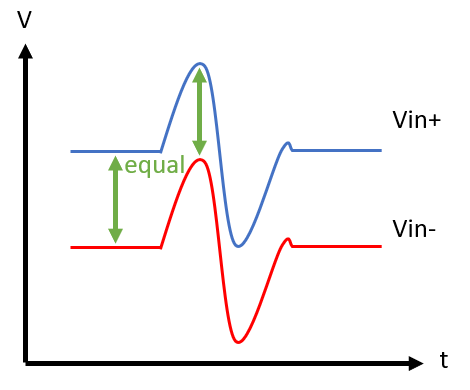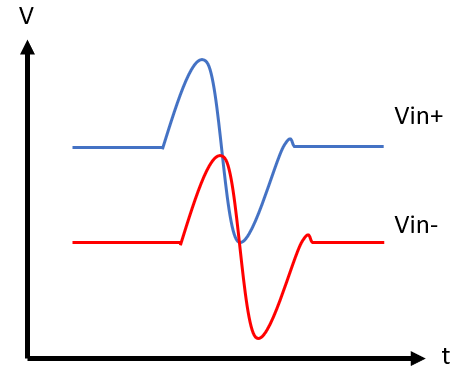Dear team,
Could you kindly help me to check that would it cause any advantage or disadvantage in this topology?
Customer used it to OVP circuit, and ask if there is any reference or document.

Thanks you for your help.
Best regards,
Tibber Peng
This thread has been locked.
If you have a related question, please click the "Ask a related question" button in the top right corner. The newly created question will be automatically linked to this question.
Dear team,
Could you kindly help me to check that would it cause any advantage or disadvantage in this topology?
Customer used it to OVP circuit, and ask if there is any reference or document.

Thanks you for your help.
Best regards,
Tibber Peng
Hi Tibber,
the ideal situation was:
1. You remove unwanted noise and glitches from the input signal having the potential of causing mistriggering by the help of a suited RC low pass filter at the -input of comparator. You could mount a filtering cap in parallel R44, or by other words, to signal ground.
But if you mount this cap between the inputs of comparator, you merely inject the noise into the +input of comparator. By this the noise isn't removed at all and can make things even worse.
2. You use a noise and glitch free VREF at the +input of comparator. For this you can split R45 into a series circuit of a smaller resistance (let's say 100...470R) and a higher resistance. Connect a filter cap from the connection point of these two resistors to signal ground.
But if you mount this cap between the inputs of comparator, you merely inject the noise into the -input of comparator. By this the noise isn't removed at all and can make things even worse.
3. You allow the comparator to toggle as fast as possible through the threshold region by providing a hysteresis. For this you connect a high ohmic resistor from the output of comparator to its +input and provide a positive feedback (hysteresis).
But if you mount a cap between the inputs of comparator, you do exactly the opposite. You slow down the comparator and don't allow the comparator to toggle as fast as possible through the threshold region.
So, do you know now what I think about the cap between the inputs of comparator?
Kai
Thanks Kai for the wonderful support.
Tibber, we don't recommend putting the cap on the inputs of the comparator due to reasons Kai listed. It is much better to provide hysteresis via positive feedback with a resistor if you expect noise from the inputs.
Dear Kai,
Thanks for your fully reply.
I have some questions about the section one.
Actually, it will inject the noise into the +input of comparator because of low impedance cap, but it also proved that capacitors react against changes in voltage.
Isn't it a advantage in this situation?
And I will suggest my customer the third method first, thanks a lot.
Best regards,
Tibber Peng
Hi Tibber,
Actually, it will inject the noise into the +input of comparator because of low impedance cap, but it also proved that capacitors react against changes in voltage.
Isn't it a advantage in this situation?
A cap between the inputs looks like a short circuit at high frequencies and forces the two inputs to assume the same potential. This will increase the risk of oscillations and mistriggering. This is not good.
In a comparator circuit you want to see just the opposite. Both input voltages shall be different most of the time. That's why hysteresis is added: When the input voltages are close to each other and the output toggles, the positive feedback (hysteresis) immediately increases the voltage difference between the inputs again.
The cap between the inputs may help in some rare situations. But below the line it will do more harm than good. I would never place a cap between the inputs of a comparator.
And I will suggest my customer the third method first, thanks a lot.
Keep in mind that the hysteresis will only work well without the cap between the inputs. A cap between the inputs would again slow down the traverse through the threshold region and would be highly counterproductive.
Kai
Dear Kai,
Thanks for your reply.
In the analysis of circuit, it can be divided into DC + AC.
As you said, a cap between the inputs looks like a short circuit at high frequencies and forces the two inputs to assume the same potential. It happened at AC analysis. But in the DC analysis, the potential won't be effected.
If there is not phase shift, the same potential in AC analysis would be the advantage.

But if there is any phase shift, it may cause mistriggering like below.

Is my understanding correct?
Best regards,
Tibber Peng
Tibber
Thanks for your post on the forum. I am aligned with Kai's assessment and I am failing to understand why you are pursuing this further. If for some reason your system benefits from having this capacitor as you eluded to this being advantage, you will not be causing any damage to the device and you can proceed with implementing it that way.
Chuck